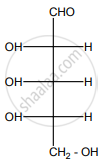Advertisements
Advertisements
Question
Give scientific reasons:
The disaccharide sucrose gives negative Tollens test while the disaccharide maltose gives a positive Tollens test.
Solution
- The structure of sucrose contains glycosidic linkage between C-1 of α-glucose and C-2 of β-fructose.
- Since the potential aldehyde and ketone groups of both the monosaccharide units are involved in the formation of the glycosidic bond (i.e., α, β-1,2- glycosidic bond), sucrose is a non-reducing sugar and gives negative Tollen’s test.
- The glycosidic bond in maltose is in between C-1 of one glucose ring and C-4 of the other (i.e., α -1,4-glycosidic linkage).
- The hemiacetal group at C-1 of the second ring is not involved in the glycosidic linkage. Hence, maltose is a reducing sugar and gives positive Tollen’s test.
APPEARS IN
RELATED QUESTIONS
Glucose on oxidation with dilute nitric acid gives _______________
Classify the following carbohydrates into monosaccharide, disaccharide, oligosaccharide and polysaccharide:
glucose, cellulose, maltose, stachyose
Define carbohydrates.
Draw the Haworth projection structure of the following.
α-D-(–)-Fructofuranose
Write a chemical reaction to convert glucose into glucose cyanohydrin.
Write a commercial method for preparation of glucose.
What is monosaccharide?
Identify the bond that links the carbon of two adjacent monosaccharides.
From the following identify an example of disaccharides.
Identify the substances having glycosidic bond and peptide bond, respectively in their structure:
Which of the following monosaccharide is a ketohexose?
Which of the following molecules reduces Fehling's solution?
Identify the product Y in the following reaction.
\[\ce{Maltose ->[Hydrolysis] X ->[dil. HNO3][(excess)] Y}\]
What is the product obtained when Br2 water reacts with glucose?
The number of sp2 and sp3 hybridised carbon in fructose are respectively ____________.
Complete hydrolysis of cellulose gives ____________.
Classify the following into monosaccharides, oligosaccharides and polysaccharides.
Fructose
Is the following sugar, D-sugar or L-sugar?

Starch and cellulose are compounds made up of many units of ______.
Formation of gluconic acid from glucose by oxidation using Br2 water.
Why carbohydrates are generally optically active.
Why carbohydrates are generally optically active.
Why carbohydrates are generally optically active?
Why are carbohydrates generally optically active?
Write the Zwitter ion structure of alanine.
Why carbohydrates are generally optically active?
Why carbohydrates are generally optically active.
